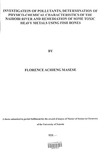Investigation of pollutants, determination of physico-chemical characteristics of the Nairobi river and remediation of some toxic heavy metals using fish bones

View/
Date
2010Author
Masese, Florence Achieng
Type
ThesisLanguage
enMetadata
Show full item recordAbstract
A Study was conducted to determine the level of pollution in the Nairobi River. The study covered four
sampling sites located along the river, stretching from upstream at Ondiri swamp then moving to
Museum Hill Bridge then further down to Race Course and finally downstream at Outer Ring Road
Bridge. Sampling was done once a month for a period of six months starting in November 2008 and
ending inApril 2009. The sampling carried out covered the wet and dry months.
At each sampling site, composite samples of water and sediment were taken. The samples were
prepared, preserved and analysed according to standard methods reported in Greenberg et al, (1992).
The analysis, identification and quantification of pollutants were carried out at the University of
Nairobi, Department of Chemistry.
The parameters investigated included physico-chemical parameters [pH, temperature, conductivity,
alkalinity, Total Dissolved Solids (TDS), Total Suspended Solids (TSS), Chemical Oxygen Demand
(COD) and Biochemical Oxygen Demand (BOD)], toxic heavy metals [lead, cadmium and Chromium].
organics [oil and grease], one nutrient [phosphate] and one anion [Chloride]. The appearance of water
was also assessed for turbidity, colour and smell.
Toxic heavy metals were analysed using Atomic Absorption Spectrometry (AAS) and X-Ray
Fluorescence (XRF) methods. Some physico-chemical parameters were analysed by colorimetry.
volumetric analysis, gravimetric analysis and potentiometric titration, whereas analysis of oil and
grease was carried by gravimetric method based on USEPA 1664A.
Data analysis was done using Microsoft office excel and Statistical Programme for Social Scientists
(SPSS).
Results found show that in the physico-chemical analysis, pH values ranged from 6.48-8.25 with a
mean of 7.10 ±0.49. At each site pH values were within acceptable WHO, EU and KEBS limits for
natural water [6.0-8.5]. The conductivity and TDS values were positively correlated and ranged from
196-592 uSzcm with a mean of 510 ±179.5 u.Szcm and 98.7-339.3 mg/L with a mean of 251 ±93.7.
mg/L. TDS values were below acceptable WHO limits of 1000mg/L, while conductivity values were
well above acceptable WHO limits of 0.6 - 1 /lSlcm. The temperatures ranged from 19.7-32.2 -c with a
mean of 23 ±3.5 °C. The high temperature of 32.2 -c that was recorded at Ondiri Swamp was attributed
to time of sampling. TSS values ranged from 20.7-164 mg/L across the four sampling sites with a mean
of 66.3 ±38.75. mg/L. High TSS value was recorded at Race Course Bridge, while the lowest value was
recorded at Ondiri Swamp.
Dissolved oxygen in water was determined through BOD and COD. The level of BOD ranged from
333 mg/L to 4100 mg/L with a mean of 1435 ±1480.mg/L, while COD values varied between 20 and706.7
mg/L across the sampling sites with a mean of 260.6 ±248.8 mg/L. High levels of BOD and
COD were recorded at Race Course Bridge and Outer Ring Bridge. Both values were well above
acceptable WHO (2008) limits of 3- 6 mg/L.
Concentration of phosphate ions ranged from 1.4 - 8.0 ppm with a mean of 3.9 ±2.65 ppm High
concentrations (8ppm) were recorded at Ondiri Swamp and Race Course Bridge in the month of April.
In November, the concentration of phosphate ions increased from upstream to downstream
[0 -5.3 mg/L] with a mean of 2.3 ±2.25. mg/L. Chloride ion concentration ranged from 37.3 - 94.4
mg/L with a mean of 62.1 ±18.70 mg/L High concentration values were recorded at Museum Hill
Bridge and Race Course Bridge in both the dry and rainy seasons
Toxic heavy metals were analysed using XRF and AAS technique. Only lead and Chromium were
detected. The amount of lead detected using AAS technique ranged from 0.04 to 0.16 ppm with a mean
of 0.08 ±0.04 ppm , while that detected using XRF ranged from 32.95 to 176.5 ppm with a mean of
84.9 ±62.09 ppm. Chromium was detected using AAS and values ranged from 0.01 to 0.24 ppm with a
mean of 0.1 ±0.08 ppm. In both cases concentrations detected do not comply with WHO (2008)
requirements. lead (0.01 ppm) and chromium (0.05 ppm). High lead concentrations were recorded at
Race Course Bridge (176.5 ppm).
Experiments were also carried out to assess the remediation capacity of ground fish bones on heavy
metals. Water from Outer Ring sampling site was eluted through a column packed with ground fish
bones and the eluate analysed using AAS. Results from the analysis indicate a decrease in
concentration of lead ions from 0.11 to 0.08, which is 27% reduction. While conductivity values before
and after remediation reduced from 200 ~ S/cm to 101.6 ~ S/cm, this translated to a reduction of 49?/o.
Factors affecting the remediation process were also investigated. These were temperature, surface area,
time of contact and mass of fish bones. Langmuir and Freundlich models were used to fit adsorption
data for lead ion concentrations determined. From the graphical plots and value for R2, the Langmuir
data gives the best fit indicating that the adsorption process using fish bones is monolayer.
Citation
Masters of science in ChemistrySponsorhip
University of NairobiPublisher
University of Nairobi Chemistry
